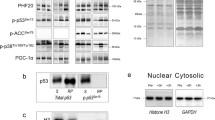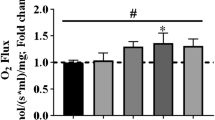Abstract
Calsequestrin (CSQ) is the main Ca2+ binding protein inside the sarcoplasmic reticulum (SR) of skeletal and cardiac muscle. The present study demonstrates the specific effects of different training regimens on CSQ isoform 1 (CSQ1, the primary isoform) and SR Ca2+-ATPase (SERCA1, 2) expression in various skeletal muscles of mouse. CSQ1, SERCA1, and SERCA2 protein expression was determined with Western blot in m. soleus (SOL), m. extensor digitorum longus (EDL), m. gastrocnemius (GAS), m. rectus femoris (RF), and m. tibialis anterior (TA) muscles after completing a 6-week endurance or sprint training program. Endurance training induced decrease in CSQ1 concentration in SOL (p < 0.001) and in SERCA1 levels in GAS (p < 0.05), whereas increase in CSQ1 expression was detected in EDL (p < 0.01). After sprint training the concentration of CSQ1 increased in GAS (p < 0.01) and EDL (p < 0.01). Additionally, sprint exercise induced an increase in SERCA1 in GAS (p < 0.001) and a decline in TA (p < 0.05). SERCA2 was up-regulated with sprint training in GAS (p < 0.01). Myosin heavy chain (MHC) based fibre type composition altered differently depending on the muscle and the training regimen.These results indicate that (1) diverse training strategies used affect differently CSQ1 and SERCA1 concentrations in the skeletal muscle, (2) the regulation of CSQ1 and SERCA1 does not necessary follow the fast-slow definition despite the correlation between MHC isoforms, and (3) the changes in CSQ1 concentration occur prior to SERCA1 or SERCA2.


Similar content being viewed by others
References
Adams GR, Hather BM, Baldwin KM, Dudley GA (1993) Skeletal muscle myosin heavy chain composition and resistance training. J Appl Physiol 74:911–915
Allen DL, Harrison DC, Maass A, Bell ML, Byrnes WC, Leinwand LA (2001) Cardiac and skeletal muscle adaptations to voluntary wheel running in the mouse. J Appl Physiol 90:1900–1908
Andersen JL, Klitgaard H, Saltin B (1994) Myosin heavy chain isoforms in single fibres from m. vastus lateralis of sprinters: influence of training. Acta Physiol Scand 150:135–142
Anttila K, Mänttäri S, Järvilehto M (2008) Testosterone and Ca2+ regulation in skeletal muscle. Int J Sports Med 29:795–802
Beard NA, Laver TR, Dulhunty AF (2004) Calsequestrin and the calcium release channel of skeletal and cardiac muscle. Prog Biophys Mol Biol 85:33–69
Berchtold MW, Brinkmeier H, Muentener M (2000) Calcium ion in skeletal muscle: its crucial role for muscle function, plasticity, and disease. Physiol Rev 80:1215–1265
Biral D, Volpe P, Damiani E, Margreth A (1992) Coexistence of two calsequestrin isoforms in rabbit slow-twitch skeletal muscle fibers. FEBS Lett 299:175–178
Bradford M (1976) A rapid and sensitive method for the quantitation of microgram quantities of protein utilizing the principle of protein-dye binding. Anal Biochem 72:248–254
Brandl CJ, deLeon S, Martin DR, MacLennan DH (1987) Adult forms of the Ca2+ ATPase of sarcoplasmic reticulum: expression in developing skeletal muscle. J Biol Chem 262:3768–3774
Damiani E, Margreth A (1990) Specific protein–protein interactions of calsequestrin with junctional sarcoplasmic reticulum of skeletal muscle. Biochem Biophys Res Commun 172:1253–1259
Damiani E, Volpe P, Margreth A (1990) Coexpression of two isoforms of calsequestrin in rabbit slow-twitch muscle. J Muscle Res Cell Motil 11:522–530
Delbono O, Meissner G (1996) Sarcoplasmic reticulum Ca2+ release in rat slow- and fast-twitch muscles. J Membr Biol 15:123–130
Delp MD, Duan C (1996) Composition and size of type I, IIa, IID/X, and IIB fibers and citrate synthase activity of rat muscle. J Appl Physiol 80:261–270
Deschenes MR, Kraemer WJ, Crivello JF, Maresh CM, Armstrong LE, Covault J (1995) The effects of different treadmill running programs on the muscle morphology of adult rats. Int J Sports Med 16:273–277
Donoghue P, Doran P, Dowling P, Ohlendieck K (2005) Differential expression of the fast skeletal muscle proteome following chronic low-frequency stimulation. Biochem Biophys Acta Proteins Proteomics 1752:166–176
Esbjornsson M, Hellsten-Westing Y, Balsom PD, Sjodin B, Jansson E (1993) Muscle fibre type changes with sprint training: effect of training pattern. Acta Physiol Scand 149:245–246
Ferreira JCB, Bacurau AV, Bueno CR Jr, Cunha TC, Tanaka LY, Jardim MA, Ramires PR, Brum PC (2010) Aerobic exercise training improves Ca2+ handling and redox status of skeletal muscle in mice. Exp Biol Med 235:497–505
Fitzsimons DP, Diffee GM, Herrick RE, Baldwin KM (1990) Effects of endurance exercise on isomyosin patterns in fast- and slow-twitch skeletal muscles. J Appl Physiol 68:1950–1955
Fliegel L, Newton E, Burns K, Michalak M (1990) Molecular cloning of cDNA encoding a 55-kDa multifunctional thyroid hormone binding protein of skeletal muscle sarcoplasmic reticulum. J Biol Chem 265:15496–15502
Franzini-Armstrong C, Kenney LJ, Varrianomarston E (1987) The structure of calsequestrin in triads of vertebrate skeletal muscle—a deep-etch study. J Cell Biol 105:49–56
Froemming GR, Murray BE, Harmon S, Pette D, Ohlendieck K (2000) Comparative analysis of the isoform expression pattern of Ca2+-regulatory membrane proteins in fast-twitch, slow-twitch, cardiac, neonatal and chronic low-frequency stimulated muscle fibers. Biochem Biophys Acta Biomembr 1466:151–168
Green HJ, Klug GA, Reichmann H (1984) Exercise-induced fibre type transitions with regard to myosin, parvalbumin, and sarcoplasmic reticulum in muscles of the rat. Pflugers Arch Eur J Physiol 400:432–438
Green HJ, Ballantyne CS, MacDougall JD, Tarnopolsky MA, Schertzer JD (2003) Adaptations in human muscle sarcoplasmic reticulum to prolonged submaximal training. J Appl Physiol 94:2034–2042
Ikemoto N, Ronjat M, Meszaros LG, Koshita M (1989) Postulated role of calsequestrin in the regulation of calcium release from sarcoplasmic-reticulum. Biochemistry 28:6764–6771
Laemmli UK (1970) Cleavage of structural proteins during assembly of head of bacteriophage T4. Nature 227:680–685
Lamb GD (2002) Excitation–contraction coupling and fatigue mechanisms in skeletal muscle: studies with mechanically skinned fibres. J Muscle Res Cell Motil 23:81–91
Lutz GJ, Bremner S, Lajevardi N, Lieber RL, Rome LC (1998) Quantitative analysis of muscle fibre type and myosin heavy chain distribution in the frog hindlimb: implications for locomotory design. J Muscle Res Cell Motil 19:717–731
MacLennan DH, Wong PTS (1971) Isolation of a calcium-sequestering protein from sarcoplasmic reticulum. Proc Natl Acad Sci USA 68:1231–1235
MacLennan DH, Rice WJ, Green NM (1997) The mechanism of Ca2+ transport by sarco(endo)plasmic reticulum Ca2+-ATpases. J Biol Chem 272:28815–28818
Mänttäri S, Anttila K, Kaakinen M, Järvilehto M (2006) Effects of low-intensity training on dihydropyridine and ryanodine receptor content in skeletal muscle of mouse. J Physiol Biochem 62:293–302
Mänttäri S, Anttila K, Järvilehto M (2008) Testosterone stimulates myoglobin expression in different muscles of the mouse. J Comp Physiol B 178:899–907
Matsunaga S, Yamada T, Mishima T, Sakamoto M, Sugiyama M, Wada M (2007) Effects of high-intensity training and acute exercise on in vitro function of rat sarcoplasmic reticulum. Eur J Appl Physiol 99:641–649
Murphy RM, Larkins NT, Mollica JP, Beard NA, Lamb GD (2009) Calsequestrin content and SERCA determine normal and maximal Ca2+ storage levels in sarcoplasmic reticulum of fast- and slow-twitch fibres of rat. J Physiol 587:443–460
Ohlendieck K, Briggs FN, Lee KF, Wechsler AW, Campbell KP (1991) Analysis of excitation-contraction-coupling components in chronically stimulated canine skeletal muscle. Eur J Biochem 202:739–747
Ohlendieck K, Fromming GR, Murray BE, Maguire PB, Leisner E, Traub I, Pette D (1999) Effects of chronic low-frequency stimulation on Ca2+-regulatory membrane proteins in rabbit fast muscle. Pfluegers Arch Eur J Physiol 438:700–708
Ørtenblad N, Lunde PK, Levin K, Andersen JL, Pedersen PK (2000) Enhanced sarcoplasmic reticulum Ca2+ release following intermittent sprint training. Am J Physiol Regul Integr Comp Physiol 279:R152–R160
Park H, Park IY, Kim E, Youn B, Fields K, Dunker AK, Kang C (2004) Comparing skeletal and cardiac calsequestrin structures and their calcium binding: a proposed mechanism for coupled calcium binding and protein polymerization. J Biol Chem 279:18026–18033
Pette D, Staron RS (2001) Transitions of muscle fiber phenotypic profiles. Histochem Cell Biol 115:359–372
Pette D, Vrbová G (1999) What does chronic electrical stimulation teach us about muscle plasticity? Muscle Nerve 22:666–677
Ross A, Leveritt M (2001) Long-term metabolic and skeletal muscle adaptations to short sprint training. Implications for sprint training and tapering. Sports Med 31:1063–1082
Sieck GC, Han YS, Prakash YS, Jones KA (1998) Cross-bridge cycling kinetics, actomyosin ATPase activity and myosin heavy chain isoforms in skeletal and smooth respiratory muscles. Comp Biochem Physiol A 119:435–450
Sullivan VK, Powers SK, Criswell DS, Tumer N, Larochelle JS, Lowenthal D (1995) Myosin heavy chain composition in young and old rat skeletal muscle: effects of endurance exercise. J Appl Physiol 78:2115–2120
Szentesi P, Zaremba R, Van Mechelen W, Stienen GJM (2001) ATP utilization for calcium uptake and force production in different types of human skeletal muscle fibres. J Physiol (Lond) 531:393–403
Towbin H, Staehelin T, Gordon J (1979) Electrophoretic transfer of proteins from polyacrylamide gels to nitrocellulose sheets: procedure and some applications. Proc Natl Acad Sci USA 76:4350–4354
Acknowledgments
We acknowledge MSc Katariina Viinikka for her contribution with the laboratory analyses, and laboratory technicians Ms. Minna Orreveteläinen and Ms. Marja-Liisa Martimo-Halmetoja for their assistance.
Author information
Authors and Affiliations
Corresponding author
Rights and permissions
About this article
Cite this article
Kinnunen, S., Mänttäri, S. Specific effects of endurance and sprint training on protein expression of calsequestrin and SERCA in mouse skeletal muscle. J Muscle Res Cell Motil 33, 123–130 (2012). https://doi.org/10.1007/s10974-012-9290-0
Received:
Accepted:
Published:
Issue Date:
DOI: https://doi.org/10.1007/s10974-012-9290-0




